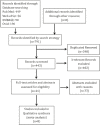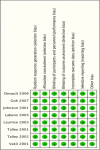Efficacy and Safety of Esomeprazole for the Treatment of Reflux Symptoms in Patients with Gastroesophageal Reflux Disease: A Systematic Review and Meta-Analysis
- PMID: 34178733
- PMCID: PMC8215048
- DOI: 10.18502/ijph.v49i12.4807
Efficacy and Safety of Esomeprazole for the Treatment of Reflux Symptoms in Patients with Gastroesophageal Reflux Disease: A Systematic Review and Meta-Analysis
Abstract
Background: We investigated the efficacy of esomeprazole for the treatment of gastroesophageal reflux disease (GERD) in a meta-analysis of clinical trials results.
Methods: Medline, Embase, PubMed and Web of Science databases were systematically searched for suitable studies, and double-blind, randomized controlled trials (RCTs) were involved. A meta-analysis of RCTs was performed to analyze the efficacy of esomeprazole on clinical outcomes that associated with the severity of GERD.
Results: A total of 8 clinical trials were selected in our meta-analysis (N=4495, patients with GERD). Esomeprazole treatment yielded a significant improvement in clinical signs and symptoms of GERD compared to placebo group. Funnel plot and Egger test showed there was no significant bias in the publication. Cochrane collaboration tool and Jadad scale were used to indicate that all 8 RCTs were of high quality. The results of Galbraith radial plot showed that no study was the major source of heterogeneity. Esomeprazole treatment significantly decreased the relapse rates more than that of placebo group (RR = 0.729; 95% CI: 0.670 to 0.794; P<0.001). It seems to be lower rates of heartburn (RR = 0.747; 95%CI: 0.665-0.839; P <0.001) and epigastric pain (RR = 0.795; 95%CI: 0.679-0.932; P =0.005) in esomeprazole-treated group compared with the placebo group. Moreover, serious adverse events was less likely to happen after esomeprazole therapy (RR = 1.406, 95% CI: 1.030-1.918; P =0.032).
Conclusion: Compared with the control group, esomeprazole is a promising therapeutic agent that improves the management of patients with GERD.
Keywords: Clinical efficacy; Esomeprazole; Gastroesophageal reflux disease; Meta-analysis; Safety.
Copyright © 2020 Hou et al. Published by Tehran University of Medical Sciences.
Conflict of interest statement
Conflict of interest The authors declare that there is no conflict of interest.
Figures






Similar articles
-
Evaluation of the effectiveness of esomeprazole treatment strategies in the management of patients with gastroesophageal reflux disease symptoms: a meta-analysis.Pharmazie. 2016 May;71(5):285-91. Pharmazie. 2016. PMID: 27348974 Review.
-
Efficacy and safety of once-daily esomeprazole for the treatment of gastroesophageal reflux disease in neonatal patients.J Pediatr. 2013 Sep;163(3):692-8.e1-2. doi: 10.1016/j.jpeds.2013.05.007. Epub 2013 Jun 22. J Pediatr. 2013. PMID: 23800403 Clinical Trial.
-
A Meta-Analysis of Efficacy and Safety of Infliximab for Prevention of Postoperative Recurrence in Patients with Crohn's Disease.Biomed Res Int. 2018 Dec 13;2018:2615978. doi: 10.1155/2018/2615978. eCollection 2018. Biomed Res Int. 2018. PMID: 30643797 Free PMC article.
-
Safety and symptom improvement with esomeprazole in adolescents with gastroesophageal reflux disease.J Pediatr Gastroenterol Nutr. 2007 Nov;45(5):520-9. doi: 10.1097/MPG.0b013e318148c17c. J Pediatr Gastroenterol Nutr. 2007. PMID: 18030228 Clinical Trial.
-
Clinical trial: esomeprazole for moderate-to-severe nighttime heartburn and gastro-oesophageal reflux disease-related sleep disturbances.Aliment Pharmacol Ther. 2010 Jul;32(2):182-90. doi: 10.1111/j.1365-2036.2010.04339.x. Epub 2010 Apr 29. Aliment Pharmacol Ther. 2010. PMID: 20456306 Clinical Trial.
Cited by
-
Esomeprazole's Antifibrotic Effects on Rats With Epidural Fibrosis.Global Spine J. 2025 Jun;15(5):2611-2616. doi: 10.1177/21925682241306045. Epub 2024 Dec 2. Global Spine J. 2025. PMID: 39622191 Free PMC article.
-
Antibiotic Cocktail Exacerbates Esomeprazole-Induced Intestinal Dysmotility While Ameliorating Gastric Dyspepsia in Mice.Antibiotics (Basel). 2025 Apr 27;14(5):442. doi: 10.3390/antibiotics14050442. Antibiotics (Basel). 2025. PMID: 40426509 Free PMC article.
-
Chitosan/hesperidin nanoparticles formulation: a promising approach against ethanol-induced gastric ulcers via Sirt1/FOXO1/PGC-1α/HO-1 pathway.Front Pharmacol. 2024 Sep 9;15:1433793. doi: 10.3389/fphar.2024.1433793. eCollection 2024. Front Pharmacol. 2024. PMID: 39314751 Free PMC article.
-
Lansoprazole plus levosulpiride versus esomeprazole in participants with gastroesophageal reflux disease and erosive esophagitis: a double blinded randomized control trial.Ann Med Surg (Lond). 2023 Sep 6;85(10):4866-4876. doi: 10.1097/MS9.0000000000001235. eCollection 2023 Oct. Ann Med Surg (Lond). 2023. PMID: 37811050 Free PMC article.
References
-
- Kellerman R, Kintanar T. (2017). Gastroesophageal Reflux Disease. Prim Care,44 (4):561–573. - PubMed
-
- Barnhart DC. (2016). Gastroesophageal reflux disease in children. Semin Pediatr Surg, 25(4):212–8. - PubMed
-
- Maqbool A, Ryan MJ. (2018). Gastroesophageal Reflux Disease and Aerodigestive Disorders. Curr Probl Pediatr Adolesc Health Care,48 (3):85–98. - PubMed
-
- Patti MG. (2016). An Evidence-Based Approach to the Treatment of Gastroesophageal Reflux Disease. JAMA Surg,151 (1):73–8. - PubMed
Publication types
LinkOut - more resources
Full Text Sources
